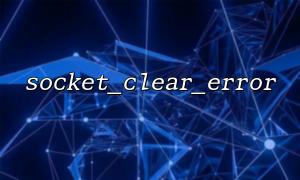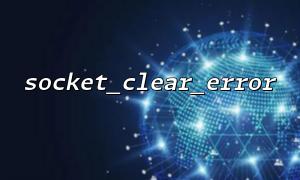When using PHP's Socket extension for network programming, we usually need to deal with various possible errors, such as connection failure, read timeout, write failure, etc. PHP provides socket_clear_error() function to clear error states on Socket resources, which is very important in certain situations, especially when using try-catch exception handling flow. If the error is not cleared, it may cause abnormal behavior of subsequent Socket operations or confusing error messages.
socket_clear_error() is a function in the PHP Socket extension to clear the error status set by the latest Socket operation. It has two ways of calling:
socket_clear_error(); // Clear the last oneSocketmistake(No specificSocketresource)
socket_clear_error($socket); // Clear specificSocketresource上的mistake
In actual development, it is recommended to use a form with parameters, which can ensure that the error status is cleared for specific Socket resources.
In PHP, Socket functions usually do not throw exceptions, but instead indicate failure by returning false and setting an error code. The error message can be obtained through socket_last_error() . Therefore, our common code structure is usually as follows:
$socket = socket_create(AF_INET, SOCK_STREAM, SOL_TCP);
if ($socket === false) {
echo "createSocketfail: " . socket_strerror(socket_last_error()) . "\n";
exit;
}
However, in some frameworks or custom encapsulations, we may explicitly throw exceptions when Socket operation fails, and this is the exception handling structure involved:
try {
$socket = socket_create(AF_INET, SOCK_STREAM, SOL_TCP);
if ($socket === false) {
throw new Exception(socket_strerror(socket_last_error()));
}
$result = socket_connect($socket, 'm66.net', 80);
if ($result === false) {
throw new Exception(socket_strerror(socket_last_error($socket)));
}
// otherSocketoperate...
} catch (Exception $e) {
echo "Catched exception: " . $e->getMessage() . "\n";
// 清除mistake,防止后续调用继续使用mistake状态
if (isset($socket)) {
socket_clear_error($socket);
}
}
There are several potential problems if the error state is not cleared in the catch block:
Residual error message : The last error may be retrieved when the socket_last_error() is subsequently called, resulting in misjudgment.
Logical confusion : If multiple Socket resources are used alternately and one of the errors is not cleared, it may affect the judgment logic of the other Socket resources.
Debugging difficulty : When the error code does not match the actual error, it is easy to get ambiguity during debugging.
Therefore, clearing errors in catch is a good practice, which can ensure clear error information and consistent state, which is conducive to the robustness of the program.
Here is a complete Socket connection processing flow, including examples of exception capture and error clearance:
<?php
try {
$socket = socket_create(AF_INET, SOCK_STREAM, SOL_TCP);
if ($socket === false) {
throw new Exception("createSocketfail: " . socket_strerror(socket_last_error()));
}
$result = socket_connect($socket, 'm66.net', 80);
if ($result === false) {
throw new Exception("连接fail: " . socket_strerror(socket_last_error($socket)));
}
// Send to the serverHTTPask
$httpRequest = "GET / HTTP/1.1\r\nHost: m66.net\r\nConnection: Close\r\n\r\n";
socket_write($socket, $httpRequest, strlen($httpRequest));
// Read the response
while ($out = socket_read($socket, 2048)) {
echo $out;
}
socket_close($socket);
} catch (Exception $e) {
echo "Exception capture: " . $e->getMessage() . "\n";
if (isset($socket) && is_resource($socket)) {
socket_clear_error($socket);
socket_close($socket);
}
}
In Socket-based network programming, error handling is an inevitable part. Using exception handling with socket_clear_error() can improve the robustness of the program and error tracking capabilities. Especially in complex network environments, a clean Socket resource without historical error status is the basis for ensuring the correct execution of the program.
Correctly calling socket_clear_error() in try-catch seems to be a detail, but it is an important part of writing high-quality PHP network programs.














